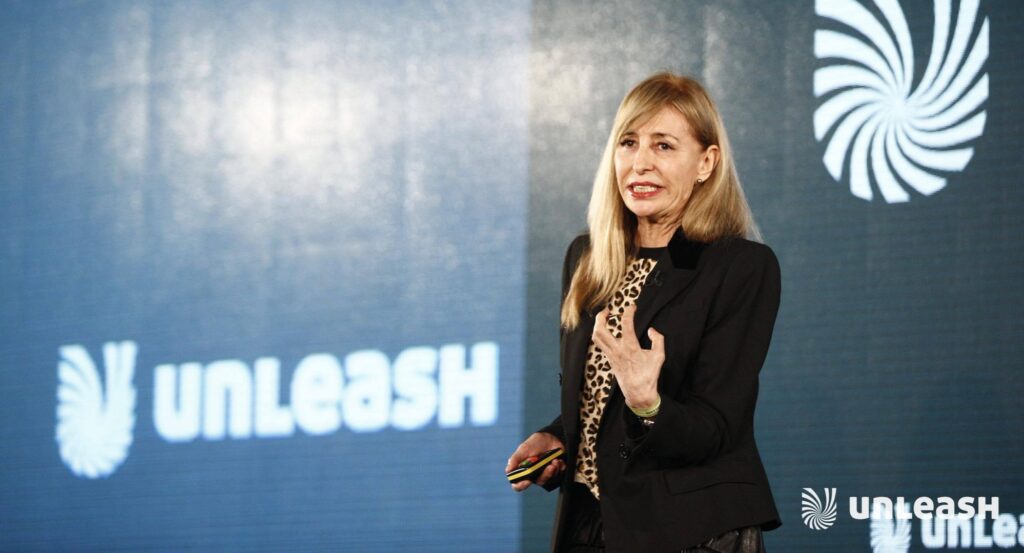What do humans do best? We learn. In a fascinating quick-fire lesson on neuroscience at UNLEASH London this year, Baroness Susan Greenfield couldn’t emphasise this enough. One important lesson we’ve not yet learnt though is that technology is having a damaging impact on our brain’s development.
Neuroplasticity is a critical feature of our brain’s development. As we grow and adapt to new experiences, our brain cells are strengthened through connections. And the more we do or practice something, the bigger the effect on the brain, stated Baroness Susan Greenfield when opening her session on day two of UNLEASH London 2019.
Musicians, mathematicians and basketball players, for example, will have physically changed their brain through continuously honing their skills. London taxi drivers, Greenfield pointed out, have been found to have a bigger hippocampi than other humans because of their need to navigate around the labyrinthine streets of the big smoke.
If you compared the scan of a taxi driver with a non taxi driver you would see brain cells in the hippocampus of the taxi driver with far more extensive branches. This is what happens if a brain cell is made to work hard, Greenfield explains. It grows more branches thus enabling space for other cells to connect up. And this in turn helps to advance our proficiency in whatever skill we are developing.
But be warned, “this is a ‘use it or lose it’ principle,” states Greenfield.
Rather than supporting our lives, much of the technology we use today has led us to create cyber lives that are highly addictive.
What makes us unique?
As we develop from childhood and through our adult lives, the connections created within our brains change the meaning we assign to things.
Greenfield used the example of showing a young child a wedding ring. To them the ring will just be a shiny thing to play with, through time they will learn that the shape of the ring means that it can be put on a finger. Then they will learn that the ring is designed to go on a specific finger and is a symbol of marriage. Perhaps later in life they will marry… and then divorce, which will give a new meaning to the ring. But this meaning will be unique to that particular individual.
“Everyone has a unique trajectory. Your present is formed by your highly personalised background. You have a path, a story, which is all attributable to the connections made between your brain cells,” Greenfield explains.
How is technology today impacting our brains?
Whereas technology in the past was used as a tool to enrich people’s lives, Greenfield argues that technology in the 21st Century is far more damaging.
Rather than supporting our lives, much of the technology we use today has led us to create cyber lives that are highly addictive, cause identity loss and lead to poor critical thought. We spend time and money in this parallel world, sacrificing our development in the real world.
Today’s young people have grown up a slave to social media due to social priming. Video games are like “electronic heroin”, designed to keep you online for as long as possible, Greenfield asserts. And we are breeding people who would prefer to administer themselves electric shocks than sit quietly for 15 minutes alone with their thoughts.
What are the implications of this technology obsession on young people in the workplace? Employers will face the challenge of dealing with workers with short attention spans, poor critical thought, reduced interpersonal skills, technology addictions and unhealthy, reckless behaviours. Greenfield concluded that we will essentially be working with three-year-old “glassy-eyed” employees in our businesses.
Putting ourselves back in nature, opening our mind up to imaginative thoughts and enriching all of our senses has huge cognitive benefits.
How can we overcome this?
It’s important to help people find their sense of self in the real world again, to feel enriched by the world around them and not get lost in a digital world that leads to the demise of our brain development.
Greenfield believes that nurturing a sense of past, present and future – rather than being hit with instant gratification in the here and now – will help people find their identity in the physical world again and enhance the production of neurons for better brain health.
“A thought has a beginning, middle and end whereas an emotion is just in the moment,” argues Greenfield. “Screens are faster, brighter and dependent on the moment. So we need to think of ways to give people back their identity – of providing a life story with time passing.”
Therefore instead of multi-tasking we should be promoting sequencing, which includes activities such as running, gardening, cooking and playing music, says Greenfield.
Putting ourselves back in nature, opening our mind up to imaginative thoughts and enriching all of our senses has huge cognitive benefits and enables a stronger sense of identity.
And employers too should consider how they can promote these brain-positive behaviours among their employees both inside and outside the workplace.
Microsoft, for example, have created an outdoor meeting space within tree houses. This may not be feasible for many businesses today, but encouraging people to hold meetings in a nearby outside space or conduct walking meetings is a good alternative. Other ideas for promoting life-enriching behaviour includes arranging volunteering days within local community gardens, holding regular charity bake sales and setting up exercise clubs.
As Generation Z – who will have grown up during the rise of digital – starts to enter the workforce, it’s more important than ever to embed these kinds of brain healthy activities within company culture.
This is not to say that we should be rejecting technology altogether and going back to basics. Advances in technology are making our day-to-day lives much easier and there is amazing potential to solve some of society’s biggest challenges through tech. But this is exactly how we should see the digital world, Greenfield asserts: “As a means to an end. Not an end in itself.”






